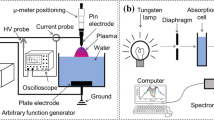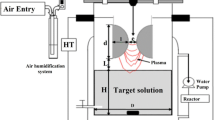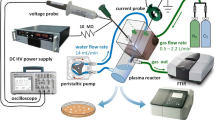Abstract
The rise of water effluents containing emerging contaminants that resist conventional chemical and physical treatments makes the treatment of wastewater more complex. Plasma-based treatment methods have great potential to degrade many of the emerging contaminants, including dyes. In this study, using pulsed nanosecond discharges, we investigate the degradation of methylene blue (MB) dye in water by generating plasma in Ar-O2 gas bubbles in water. The scalability of the setup is studied by producing discharges in a one electrode setup (a needle-to-plate configuration) and in a four electrodes setup (four needles-to-wire configuration). The discharge was characterized by electrical measurements (current and voltage waveforms) and optical emission spectroscopy. We find that the discharge properties are stable during the 30 min of processing, with and without the presence of MB in solution at low electrical conductivity. The production rate of H2O2 in the one electrode setup was measured in 0% and 70% O2, and it was found to be ∼2.3 and 2.9 mg/Lmin, respectively. In the four electrodes setup, H2O2 production rate was lower: ∼1.2 and 1.9 mg/Lmin in 0% and 100% O2. Degradation of MB was assessed in both setups for (i) different % of O2 in the gas mixture, (ii) different MB initial concentration, and (iii) different initial water conductivity. In the one electrode setup, a high MB degradation (> 85%) was generally achieved in all conditions, but a better performance is noted in high O2 percentage (> 50%) at low initial water conductivity. At low MB concentration and low electrical conductivity, the performance of the four electrodes setup was better than the one electrode setup.

















Similar content being viewed by others
Data Availability
No datasets were generated or analysed during the current study.
References
Hassaan MA, Nemr E, A., Hassaan A (2017) Health and environmental impacts of dyes: mini review. Am J Environ Sci Eng 1(3):64–67
Manzoor J, Sharma M (2020) Impact of textile dyes on human health and environment. Impact of textile dyes on public health and the environment. IGI Global, pp 162–169
Magureanu M, Mandache NB, Parvulescu VI (2007) Degradation of organic dyes in water by electrical discharges. Plasma Chem Plasma Process 27:589–598
Hamdan A, Liu JL, Cha MS (2018) Microwave plasma jet in water: characterization and feasibility to wastewater treatment. Plasma Chem Plasma Process 38:1003–1020
Diamond J, Profili J, Hamdan A (2019) Characterization of various air plasma discharge modes in contact with water and their effect on the degradation of reactive dyes. Plasma Chem Plasma Process 39:1483–1498
Krosuri A, Wu S, Bashir MA, Walquist M (2021) Efficient degradation and mineralization of methylene blue via continuous-flow electrohydraulic plasma discharge. J Water Process Eng 40:101926
Magureanu M, Piroi D, Mandache NB, David V, Medvedovici A, Parvulescu VI (2010) Degradation of pharmaceutical compound pentoxifylline in water by non-thermal plasma treatment. Water Res 44(11):3445–3453
Malik MA, Ghaffar A, Ahmed K (2002) Synergistic effect of pulsed corona discharges and ozonation on decolourization of methylene blue in water. Plasma Sources Sci Technol 11(3):236
Magureanu M, Bradu C, Piroi D, Mandache NB, Parvulescu V (2013) Pulsed corona discharge for degradation of methylene blue in water. Plasma Chem Plasma Process 33:51–64
Lukes P, Appleton AT, Locke BR (2004) Hydrogen peroxide and ozone formation in hybrid gas-liquid electrical discharge reactors. IEEE Trans Ind Appl 40(1):60–67
Hsieh KC, Wang H, Locke BR (2016) Analysis of Electrical Discharge plasma in a gas-liquid Flow Reactor using Optical Emission Spectroscopy and the formation of Hydrogen Peroxide. Plasma Processes Polym 13(9):908–917
Sahni M, Locke BR (2006) Quantification of hydroxyl radicals produced in aqueous phase pulsed electrical discharge reactors. Industrial& Eng Chemistryresearch 45(17):5819–5825
Lukes P, Clupek M, Babicky V, Janda V, Sunka P (2005) Generation of ozone by pulsed corona discharge over water surface in hybrid gas–liquid electrical discharge reactor. J Phys D 38(3):409
Baroch P, Anita V, Saito N, Takai O (2008) Bipolar pulsed electrical discharge for decomposition of organic compounds in water. J Electrostat 66(5–6):294–299
Sugiarto AT, Ito S, Ohshima T, Sato M, Skalny JD (2003) Oxidative decoloration of dyes by pulsed discharge plasma in water. J Electrostat 58(1–2):135–145
Dang TH, Denat A, Lesaint O, Teissedre G (2009) Pulsed electrical discharges in water for removal of organic pollutants: a comparative study. Eur Phys Journal-Applied Phys 47(2):22818
El Shaer M, Eldaly M, Heikal G, Sharaf Y, Diab H, Mobasher M, Rousseau A (2020) Antibiotics degradation and bacteria inactivation in water by cold atmospheric plasma discharges above and below water surface. Plasma Chem Plasma Process 40:971–983
Matsui Y, Takeuchi N, Sasaki K, Hayashi R, Yasuoka K (2011) Experimental and theoretical study of acetic-acid decomposition by a pulsed dielectric-barrier plasma in a gas–liquid two-phase flow. Plasma Sources Sci Technol 20(3):034015
Magureanu M, Piroi D, Gherendi F, Mandache NB, Parvulescu V (2008) Decomposition of methylene blue in water by corona discharges. Plasma Chem Plasma Process 28:677–688
Nishiyama H, Niinuma K, Shinoki S, Takana H (2015) Decomposition of acetic acid using multiple bubble jets with pulsed electrical discharge. Plasma Chem Plasma Process 35:339–354
Chen YS, Zhang XS, Dai YC, Yuan WK (2004) Pulsed high-voltage discharge plasma for degradation of phenol in aqueous solution. Sep Purif Technol 34(1–3):5–12
Shih KY, Locke BR (2010) Chemical and physical characteristics of pulsed electrical discharge within gas bubbles in aqueous solutions. Plasma Chem Plasma Process 30:1–20
Wright A, Taglioli M, Montazersadgh F, Shaw A, Iza F, Bandulasena HH (2019) Microbubble-enhanced DBD plasma reactor: design, characterisation and modelling. Chem Eng Res Des 144:159–173
Bourbeau N, Soussan L, Hamdan A (2022) Degradation of methylene blue by pulsed nanosecond discharge in Ar, O2, and N2 gaseous bubbles in water: evaluation of direct and postprocessing modes. J Vacuum Sci &Technology A, 40(5)
Sun B, Sato M, Clements JS (1999) Use of a pulsed high-voltage discharge for removal of organic compounds in aqueous solution. Journal of Physics D: Applied Physics, 32(15), 1908
Zhang Y, Zhou M, Hao X, Lei L (2007) Degradation mechanisms of 4-chlorophenol in a novel gas–liquid hybrid discharge reactor by pulsed high voltage system with oxygen or nitrogen bubbling. Chemosphere 67(4):702–711
Grabowski LR, Van Veldhuizen EM, Pemen AJM, Rutgers WR (2007) Breakdown of methylene blue and methyl orange by pulsed corona discharge. Plasma Sources Sci Technol 16(2):226
Talviste R, Erme K, Paris P, Raud J, Plank T, Jõgi I (2022) Effective ionization coefficient in mixtures of ar and O2 determined using the Townsend discharge. AIP Adv, 12(10)
Locke BR, Shih KY (2011) Review of the methods to form hydrogen peroxide in electrical discharge plasma with liquid water. Plasma Sources Sci Technol 20(3):034006
Magureanu M, Bradu C, Parvulescu VI (2018) Plasma processes for the treatment of water contaminated with harmful organic compounds. J Phys D 51(31):313002
https://www.masterorganicchemistry.com/2016/09/16/introduction-to-uv-vis-spectroscopy/
Sugai T, Nguyen PT, Maruyama T, Tokuchi A, Jiang W (2016) The effect of scale-up of pulsed corona discharge for treatment of pollution water sprayed in discharge gap. IEEE Trans Plasma Sci 44(10):2204–2210
Liu ZJ, Wang WC, Zhang L, Wang S, Yang DZ, Zhang S, Tang K (2014) Electrical and optical characteristics of diffuse nanosecond pulsed discharge plasma using a needle-array electrode in atmospheric air. J Appl Phys, 115(20)
García MC, Mora M, Esquivel D, Foster JE, Rodero A, Jiménez-Sanchidrián C, Romero-Salguero FJ (2017) Microwave atmospheric pressure plasma jets for wastewater treatment: degradation of methylene blue as a model dye. Chemosphere 180:239–246
Stará Z, Krčma F, Nejezchleb M, Skalný JD (2009) Organic dye decomposition by DC diaphragm discharge in water: Effect of solution properties on dye removal. Desalination 239(1–3):283–294
Ikoma S, Satoh K, Itoh H (2009) Decomposition of methylene blue in an aqueous solution using a pulsed-discharge plasma at atmospheric pressure. IEEJ Trans Fundamentals Mater 129(4):237–244
Ishijima T, Hotta H, Sugai H, Sato M (2007) Multibubble plasma production and solvent decomposition in water by slot-excited microwave discharge. Appl Phys Lett, 91(12)
Maehara, T., Miyamoto, I., Kurokawa, K., Hashimoto, Y., Iwamae, A., Kuramoto, M.,… Kawashima, A. (2008). Degradation of methylene blue by RF plasma in water. Plasma Chemistry and Plasma Processing, 28, 467–482
Acknowledgements
The research reported in this publication was financially supported by the Natural Sciences and Engineering Research Council of Canada (NSERC), under award number RGPIN-2023-03951. The authors thank the Fonds de Recherche du Québec – Nature et Technologie (FRQ-NT) and the Canada Foundation for Innovation (CFI) for funding the research infrastructure.
Funding
This work was financially supported by the National Science and Engineering Research Council (NSERC), under award numbers RGPIN-2023-03951.
Author information
Authors and Affiliations
Contributions
N A, J P, and A H wrote the main manuscript text and prepared the Figures. C G, N A, and J P did the experiments under the supervision of A H. N A, J P, A H, and I B contributed to the writing and revision of the manuscript. All authors reviewed the manuscript.
Corresponding author
Ethics declarations
Ethical Approval
Not applicable.
Competing Interests
The authors declare no competing interests.
Additional information
Publisher’s Note
Springer Nature remains neutral with regard to jurisdictional claims in published maps and institutional affiliations.
Electronic Supplementary Material
Below is the link to the electronic supplementary material.
Rights and permissions
Springer Nature or its licensor (e.g. a society or other partner) holds exclusive rights to this article under a publishing agreement with the author(s) or other rightsholder(s); author self-archiving of the accepted manuscript version of this article is solely governed by the terms of such publishing agreement and applicable law.
About this article
Cite this article
Aloui, N., Pregent, J., Gouze, C. et al. Degradation of Methylene Blue by Pulsed Nanosecond Discharge in Water with Ar-O2 Gaseous Bubbles. Plasma Chem Plasma Process (2024). https://doi.org/10.1007/s11090-024-10468-6
Received:
Accepted:
Published:
DOI: https://doi.org/10.1007/s11090-024-10468-6




